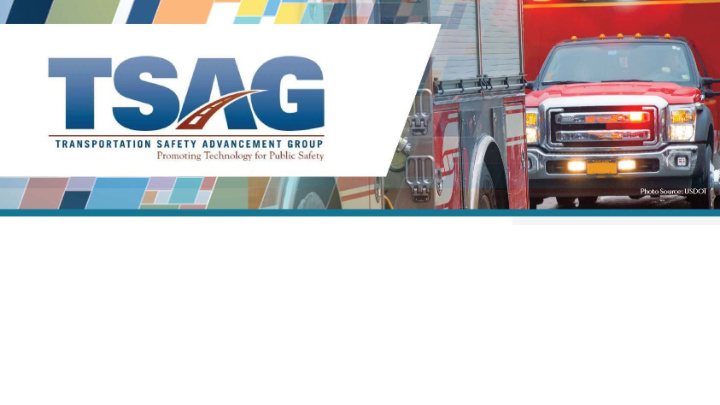



What is TSAG • TSAG is a group of transportation and public safety professionals working with the USDOT to address safety needs through proven and emerging technologies • TSAG represents nine communities of interest focused on various aspects of enhancing public and responder safety on transportation facilities • TSAG supports research and education in technology to improve responder safety
TSAG Communities of Interest • Emergency Management • Emergency Communications • Technology and Telematics • Law Enforcement • Academic and Research • Emergency Medical Services • Governing Agencies • Fire and Rescue • Transportation Operations
Why is TSAG Important • TSAG focuses on improving the safety of public safety responders on roads and highways • In 2019, 44 public safety responder fatalities resulted from being struck on roadways: 18 law enforcement, 14 tow truck operators, 3 mobile mechanics, and 9 fire/EMS • New and emerging technologies for traveler and emergency responder safety can save lives • New technologies simplify situational awareness and enhance warning capabilities • Technology applications can make response safer and easier
What is TSAG Doing to Enhance Safety • TSAG researches and promotes technology applications that provide easy access to critical information and improve responder safety • TSAG supports research and education in technology to improve responder safety through knowledge, awareness, and information exchange. • Recent research looks at: • FirstNet, NG 911, and Connected Vehicles • Advanced Automated Collision Notification (AACN) • I2R Future Opportunities • Connected Responder
FirstNet and NG911
FirstNet and NG911 Call to Action • Build out and deployment of the NG 911 system • Build out of FirstNet network • New applications and devices to take advantage of NG 911 and FirstNet capabilities • Federal determination of spectrum use
Advanced Automatic Collision Notification (AACN) • Sends crash data from vehicle to emergency responders • Information may include: • Location of crash • Airbag deployment • Crash severity • Multiple impacts
Evolution of ACN/AACN • Automatic Crash Notification (ACN) • Basic vehicle crash information (airbag deployment and location) • Calls go to call taker in telematic service provider (TSP) center • TSP call taker verbally notifies PSAP • Advanced Automatic Crash Notification (AACN) • Includes additional information from vehicle sensors • Information transmitted to TSP or directly to PSAP
Evolution of ACN/AACN (cont) • NG-AACN • Uses NextGen 9-1-1 • Transmits voice and data at the same time • Supports video from in-vehicle or responder camera • Allows data to be displayed to PSAP call taker • Call taker able to request updated vehicle data
Call taker contacts Vehicle data vehicle transmitted occupants to PSAP Level 1 Trauma Center activated Air transport dispatched Fire/rescue notified of pinned driver Photo: FEMA/Jocelyn Augustino
AACN Call to Action • Federal investment in deployment of NG9-1-1 • AACN included in CAV standards • AACN in New Car Assessment Program (NCAP) • Pilot project to test and develop AACN protocols • Support modification of response protocols • Advance understanding of AACN through information campaign
Infrastructure to Responder (I2R) • Connecting responders to information from a wide array of sources • Civil infrastructure • Vehicles • Sensors • Geospatial data bases • I2X provides a basis for I2R • V2X provides connectivity to response vehicles and between vehicles and responders
I2R Opportunities • Internet of Things (IoT) • Smart Communities • 5G • Mobile Cloud Computing • Edge Computing
Bridge Video feed status of the scene Carrier Available manifest Nearby Resources waterways Scene intrusion monitoring Source: Mansfield Fire Dept.
Location and status of power lines Surface conditions Available Spot Resources weather Location of stormwater inlets Source: FEMA/Scott E. Schermerhorn
I2R Research and Development Needs • Hardware • Data Integration • User Needs • User Interface
Connected Responder “ NHTSA estimates that • Improve responder and public safety applications enabled safety by V2V and V2I could • Reduce agency costs (direct and eliminate or mitigate the indirect) severity of up to 80 percent • Capitalize on growing commercial of non-impaired crashes, and private CV network including crashes at • Influence positive change for intersections or while profession and public changing lanes”
Connected Responder Use Case
Connected Responder Call to Action • Opportunities for application are limitless • Become involved in the development of the technologies and associated standards and specifications • Become a business driver for the vehicle manufacturers to adopt more quickly • Become early adopters
How Can Your Organization Support TSAG Initiatives • Support research on the benefits of emerging technologies • Test and pilot projects to understand, revise, and advance technology applications • Get involved in the development of new technologies to improve the usefulness of the applications • Support financial, regulatory, and legislative changes that advance technology applications
How Can Your Organization Support TSAG Initiatives (cont) • Advance and integrate new technologies through education, training, and revised protocols • Support strategic alliances, partnerships, and institutional frameworks to advance the use of new technology • Participate in activities to promote and adopt technologies that enhance traveler and responder safety
Visit us at: www.tsag-its.org
Recommend
More recommend